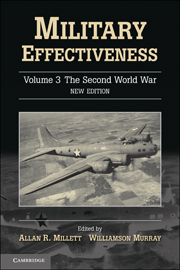Book contents
- Frontmatter
- Contents
- List of Contributors
- Introduction: Military Effectiveness Twenty Years After
- Maps
- 1 The Effectiveness of the Japanese Military Establishment in the Second World War
- 2 The United States Armed Forces in the Second World War
- 3 British Military Effectiveness in the Second World War
- 4 The Italian Armed Forces, 1940–3
- 5 The Dynamics of Volksgemeinschaft: The Effectiveness of the German Military Establishment in the Second World War
- 6 Bitter Victory: French Military Effectiveness during the Second World War
- 7 The Soviet Armed Forces in the Great Patriotic War, 1941–5
- 8 Military Effectiveness in the Second World War
- 9 Challenge and Response at the Operation and Tactical Levels, 1914–45
- 10 The Political and Strategic Dimensions of Military Effectiveness
- Index
9 - Challenge and Response at the Operation and Tactical Levels, 1914–45
Published online by Cambridge University Press: 05 June 2012
- Frontmatter
- Contents
- List of Contributors
- Introduction: Military Effectiveness Twenty Years After
- Maps
- 1 The Effectiveness of the Japanese Military Establishment in the Second World War
- 2 The United States Armed Forces in the Second World War
- 3 British Military Effectiveness in the Second World War
- 4 The Italian Armed Forces, 1940–3
- 5 The Dynamics of Volksgemeinschaft: The Effectiveness of the German Military Establishment in the Second World War
- 6 Bitter Victory: French Military Effectiveness during the Second World War
- 7 The Soviet Armed Forces in the Great Patriotic War, 1941–5
- 8 Military Effectiveness in the Second World War
- 9 Challenge and Response at the Operation and Tactical Levels, 1914–45
- 10 The Political and Strategic Dimensions of Military Effectiveness
- Index
Summary
Introduction
‘War is the great auditor of institutions.’ So wrote Correlli Barnett in his Swordbearers. The historians whose work is collected in these volumes have audited the performance of seven national military institutions in two world wars and in the long period between those wars. Only two nations, the United States and Great Britain, were victors in both wars. One, Germany, lost in both. Russia emerged defeated in the first and as a victor in the second. Italy and Japan were on the winning side in the first, and then lost in the second. France won its first war, collapsed after ten months of the second, and then with new forces raised abroad and at home after liberation by Anglo-American forces could claim to be a ‘victorious’ power at the end.
Each of the three periods was a time of challenge to national military institutions on the one hand and of response by those institutions on the other. For these nations and their military institutions, the two wars were exhausting, terrible, life or death audits. What can we learn from the manner in which these military institutions responded or failed to respond to the challenge of war and of what was, in the perspective of history, a period of two decades of preparation for war? Perhaps even more important, how can we apply what we learn to our current American military institutions?
- Type
- Chapter
- Information
- Military Effectiveness , pp. 320 - 340Publisher: Cambridge University PressPrint publication year: 2010
- 1
- Cited by



